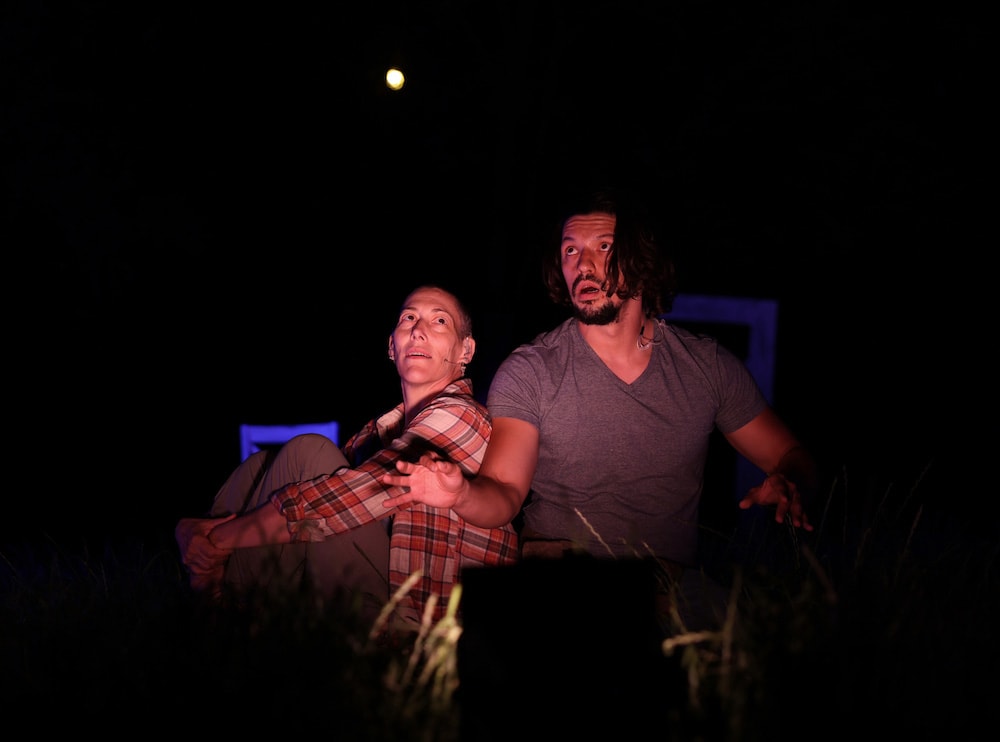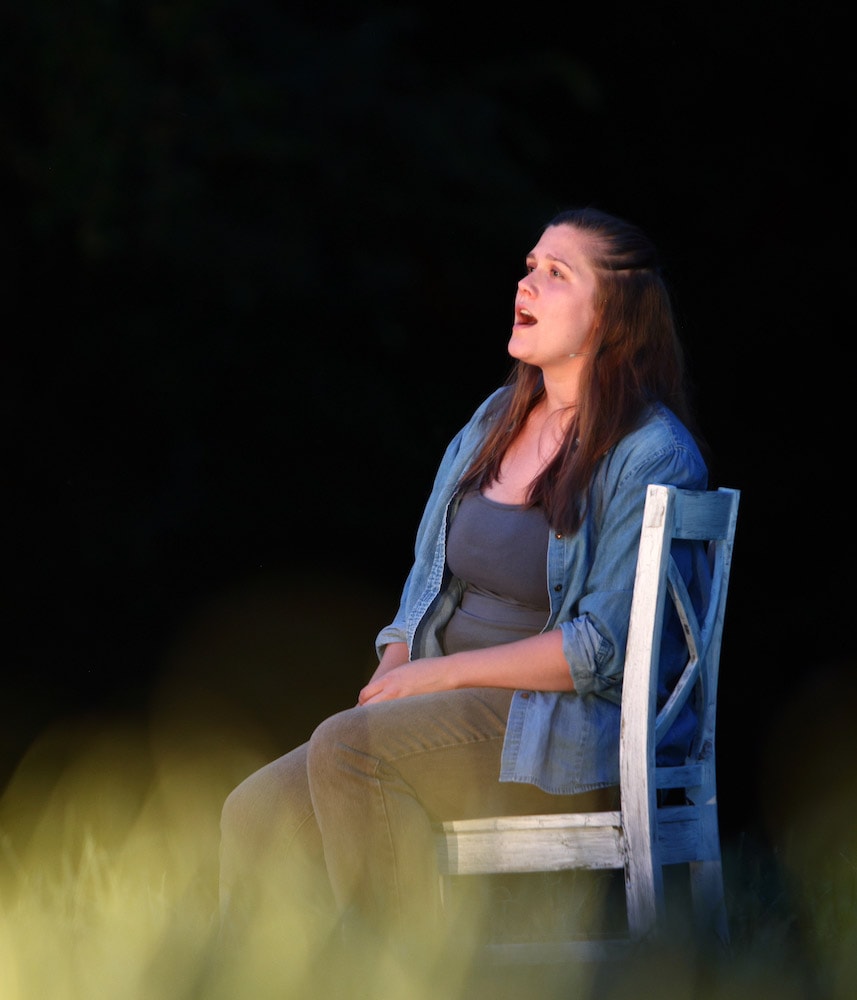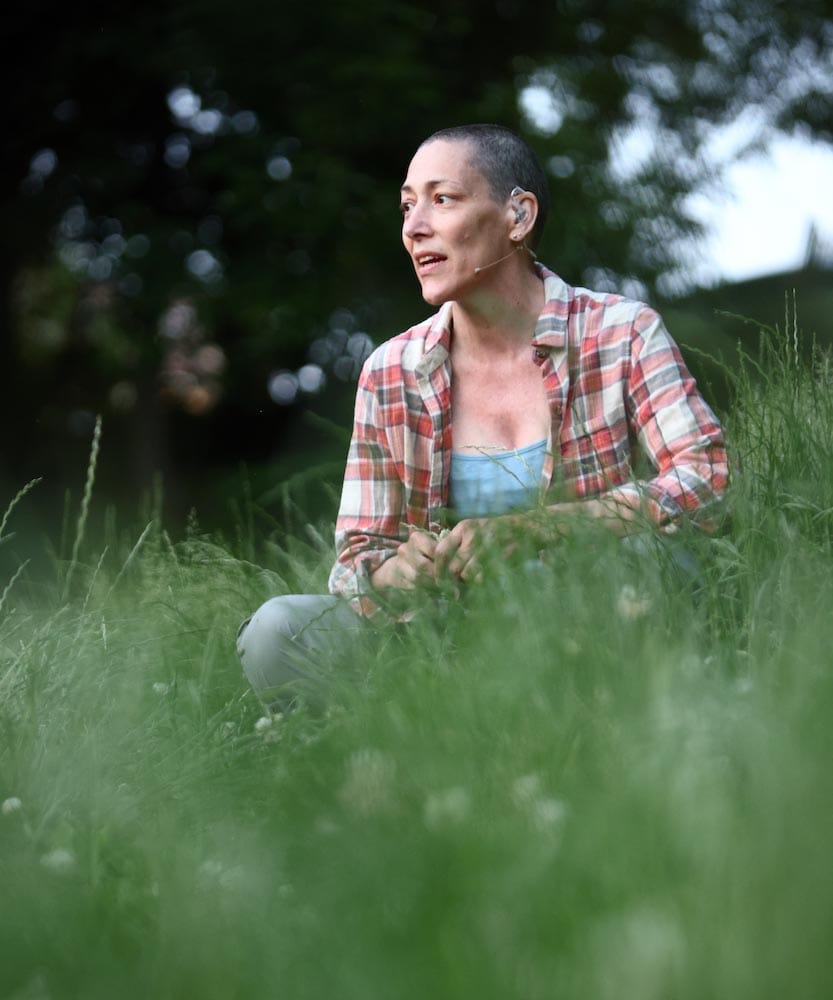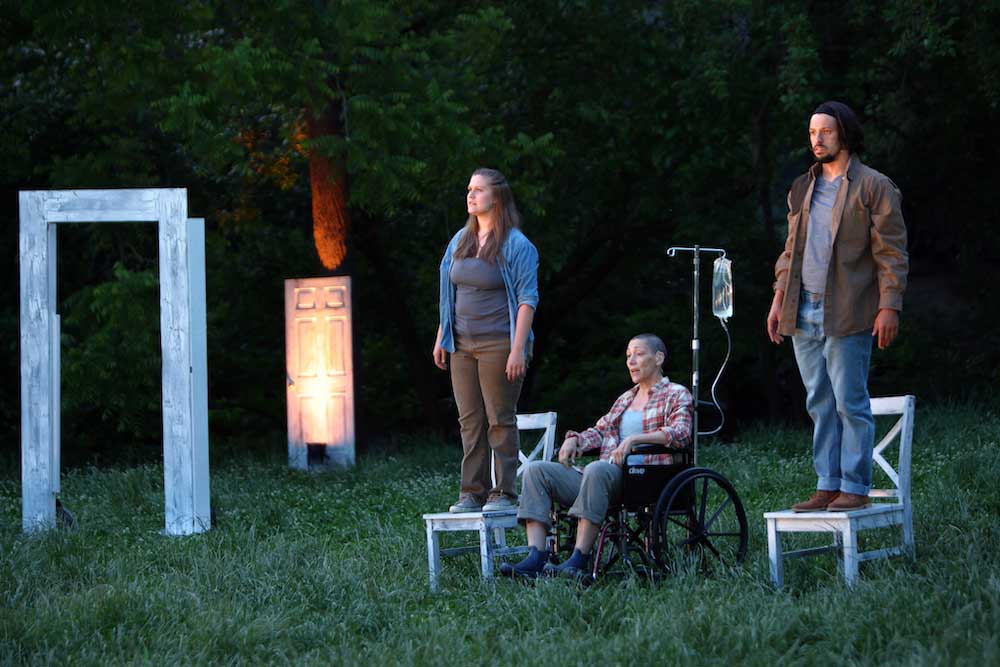There couldn’t be a more perfect setting for Irish playwright Deirdre Kinahan’s In the Middle of the Fields than the grassy, clovered slope of P Street Beach, a sliver of Rock Creek Park a quick walk from Dupont Circle in northwest DC. The natural setting, fringed by lush trees, is both cut off from and amid the urban environment — sounds of traffic, picnickers, and joggers (and a none-too-distant outdoor rock concert Saturday night) waft over the pastoral setting. Solas Nua, the Irish arts organization, has set out a half dozen blankets and about two dozen chairs — all placed an appropriate six feet apart. Headsets are distributed to amplify the actors’ voices and share the intricate sound score by Gordon Nimmo-Smith and Tosin Olufolabi. Much care has been taken in this site-specific, environmental setting for a live in-person theatrical experience — Solas Nua’s first since March 2020.
Kinahan’s intimate play, making its U.S. premiere, follows Eithne through chemotherapy as she processes her breast cancer diagnosis and her mortality and reflects on her life, relationships, and motherhood. The title derives from 20th-century Irish writer Mary Lavin’s short story of the same name, which recounts a widow’s efforts to access her strength and voice to independently manage her family farm. While drawing on her own, Kinahan was inspired by Lavin’s poetic language and bold feminist point of view in crafting this contemporary portrait of a fiercely independent and courageous woman. Written in 2019 as Kinahan was completing treatment for breast cancer, In the Middle spares little in recounting both the emotional highs and lows and the physical traumas that cancer treatment wreaks on body, mind, and soul.

The one-hour play weaves dreamlike flashbacks and cinematic hallucinations of the ravages of chemo, with mundanities and indignities of living with cancer. There are bleak scenes in hospital wards and kitchen table conversations interspersed with imagistic communions with nature and the glories of the outdoor setting. Director Laley Lippard has pared down human-made scenery to the barest essentials: three wood door frames, a few chairs, and a detached white door that serves as table, boundary, burden, and bed.
Nature itself is central to Eithne’s story — drawing her into her past, beckoning her to quiet meadows, streams, forests for moments of elemental connection with the earth, even as she wavers in her determination to give in to or face the breast cancer that has ravaged her body.
Gifted actor Jessica Lefkow — her hair closely shaved, her eyes sunken — embodies Eithne’s cancer-ravaged body, unsteady gait, and weakened physical state. But she also imbues this woman with fierce determination to hold on, and speak her mind, make clear what she needs and what she doesn’t. Early in the play, Eithne roars at her husband, Sean, for not accompanying her to her hospital visits. Later she confides to the audience, “He has failed me at every moment and doesn’t even know it.” Lefkow navigates the rage and pain, the loneliness and longing for normalcy, the morbid fear and urgent hope that shapes the cancer experience. Lefkow, too, relishes the lyrical and elegiac prose Kinahan pens, especially for the moments where Eithne connects with nature and her memory of her daughter as a toddler. The images of water, greenery, vast verdant outdoors are elemental to this character portrait.
Ryan Sellers and Caroline Dubberly adapt easily to multiple supporting roles — family members, friends, fellow cancer patients in a chemo ward, medical staff — reflecting both the physical and emotional arc of the play. There’s comedy in the sketches of types of cancer patients and pathos in wrestling with meaning and mortality woven in. Dubberly, too, composed and sings a hauntingly beautiful song of loss.

Director Lippard envisioned the chemotherapy experience as a danse macabre and enlisted chorographer Tony Thomas to craft a graphic and gruesome chemo dance sequence. Seated Lefkow, joined by Sellers and Dubberly, stretches an arm out — as if ready for the IV stick. White hot fluorescent lights flicker, electronic static rumbles, high-pitched beeps fill the provided earphones. The actors’ fingers vibrate and pulse, a static shock runs through their bent-over bodies. Then they count. One. Two. Three. The sequence repeats like a medical Greek chorus, or like chemotherapy: round one, round two, round three. Each both easier and harder than the last.
Lippard and the cast found working outdoors provided the additional challenge of traffic sounds, particularly ambulance sirens from the nearby George Washington University Hospital. Saturday evening, many viewers fiddled with their headsets to determine if the sirens were part of the sound score or not. Lippard wisely had the actors pause, and quietly listen, allowing those sirens to become another warning of the imminent menace cancer carries. It never disappears.
So often cancer is spoken and written about as a “journey” — as if anyone would choose such a trip. Others, especially those unaffected by it, call cancer a “battle” or a “fight” — and what does that say about those who succumb to the disease? They’re losers or didn’t fight hard enough? Kinahan faces down cancer for what it is: a unique experience. For everyone’s cancer diagnosis and treatment is different. In the Middle of the Fields recounts one cancer patient’s life — Eithne’s. But like all good theater, poetry, and storytelling, the specificity of the singular account is what makes for, one hopes, universal understanding. Solas Nua’s exceptional care and vision in producing this piece once more speaks to the first-rate work of this small but important company.

Eithne’s compelling avowal — “I want more … music … and books … and restaurants … and travel … and theater …. I want more. I will not settle for this” — is our own wake-up call. For those — after a year of forced isolation, loss, and suffering amid the global pandemic — ready, willing, and able to hear it, time is always running out. Cancer has touched and taken millions of loved ones, but for Eithne, she’s not ready to cede yet. It’s her — and our — wake-up call. Eithne asserts: “I will not waste a second chance.” Nor should any of us.
Running time: 55 minutes, with no intermission.
In the Middle of the Fields runs Thursdays, Fridays, and Saturdays to June 12, 2021, at P St Beach Park, 1414 22nd St NW, Washington, DC (two blocks from Dupont Circle Metro). Performances begin at 7:30 pm. Admission is free with purchase of a three-show Solas Nua Summer Theatre Membership, which starts at $55. For registration information go to solasnua.org.

Creative Team
Deirdre Kinahan – Playwright
Laley Lippard – Director
Tony Thomas – Choreographer
Marianne Meadows – Lighting Designer
Gordon Nimmo-Smith – Sound Designer
Tosin Olufolabi – Sound Designer
Rex Daugherty/Laley Lippard – Production Design
Sam Reilly – Stage Manager
Izzy Gholl – Assistant Director/Assistant Stage Manager
Shaun Delany – Sound Operator/Run Crew
Caroline Dubberly – Composer
Heather Lockard – Costume Consultant
Cast
Jessica Lefkow – Eithne
Ryan Sellers – Sean, Denis, Ronan, Jake, Marianne, Ensemble
Caroline Dubberly – Maisie, Maire, Lizzie, Numa, Ensemble
Developed by Solas Nua from an original commission by Meath County Council Arts Office.
SEE ALSO:
Solas Nua brings back live theater with ‘In the Middle of the Fields’ in a park




